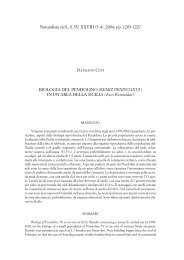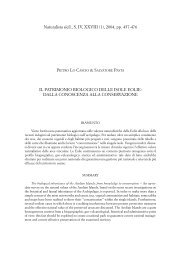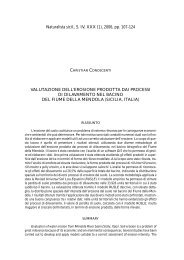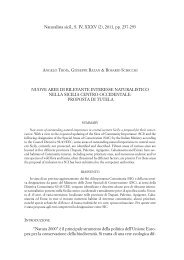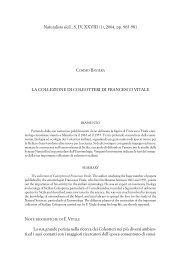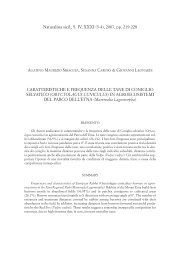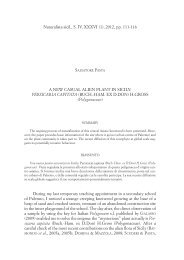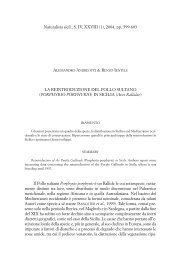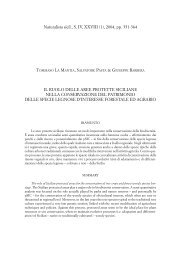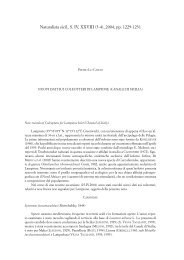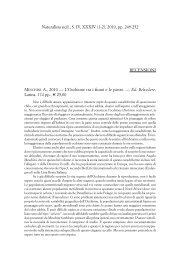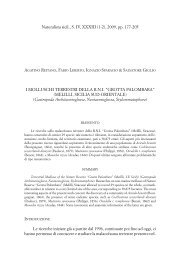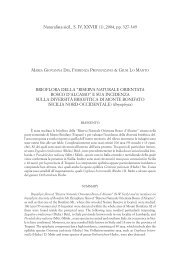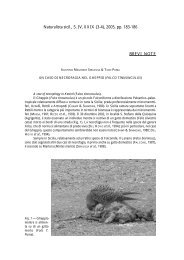2007,pp - Società Siciliana di Scienze Naturali
2007,pp - Società Siciliana di Scienze Naturali
2007,pp - Società Siciliana di Scienze Naturali
Create successful ePaper yourself
Turn your PDF publications into a flip-book with our unique Google optimized e-Paper software.
288 M. SKUHRAVÁ, V. SKUHRAVY´ & B. MASSA<br />
and named to his honour by KIEFFER & CECCONI (1906). References: DE STE-<br />
FANI (1906b), TROTTER & CECCONI (1907: N. 412): on the label it is written:<br />
“Bombay (In<strong>di</strong>a); svilu<strong>pp</strong>ato l’insetto a Palermo nel maggio 1906 (Prof. G. E.<br />
Mattei)”; material originated from In<strong>di</strong>a and adults were reared from galls in<br />
Palermo. Distribution: Euro-Asian species, known to occur in In<strong>di</strong>a, Kenya,<br />
Mauritius, Réunion, Java. It has to be considered an alien species in Sicily.<br />
Psectrosema tamaricis (De Stefani, 1902)<br />
Larvae cause swellings on branches of Tamarix gallica L. (formerly T.<br />
tetrandra L.) (Tamaricaceae). In each gall many larvae develop. Occurrence:<br />
DE STEFANI (1902) found galls in the Botanical Garden of Palermo, reared<br />
adults and described it as Rhopalomyia tamaricis. DE STEFANI jr (1942)<br />
reported in January galls again in Palermo Botanical Garden. Reference:<br />
TROTTER & CECCONI (1900-1917: N. 290), Catania and Palermo, 1902, leg.<br />
De Stefani; DE STEFANI (1906c). Distribution: Me<strong>di</strong>terranean.<br />
Pumilomyia protrahenda De Stefani, 1919<br />
Pumilomyia De Stefani, 1919<br />
Pulmilomyia De Stefani, 1929: new synonym<br />
Pumilomyia protrahenda De Stefani, 1919<br />
Pulmilomyia artemisiae De Stefani, 1929: new synonym<br />
Larvae cause small galls on leaves, leaf stalks and stems of Artemisia<br />
arborescens L. (Asteraceae). The galls are small hypertrophies of various form.<br />
Each gall includes only one larva. If galls occur in large amount, they may<br />
cause a heavy damage (stunting) of the whole host plant. DE STEFANI (1919)<br />
found attacked plants at R. Orto Botanico of Palermo, where they were very<br />
common from late January to April at his time. He reared adults, described<br />
the species, figured a damaged plant, observed the biology and established a<br />
new genus for this species. Since his time any more galls of this species have<br />
been found. Distribution: Me<strong>di</strong>terranean.<br />
Note: DE STEFANI (1929) incomprehensibly redescribed the same<br />
species with another name (Pulmilomyia artemisiae); therefore it has to be<br />
considered a new junior synonym, hitherto overlooked.<br />
Putoniella pruni (Kaltenbach, 1872)<br />
Cecidomyia pruni Kaltenbach, 1872<br />
Syn. Diplosis marsupialis F. Löw, 1889; Putoniella marsupialis (F. Löw, 1889): authors<br />
Larvae cause pouch or pocket-shaped swellings usually along the midvein<br />
on leaves of various species of Prunus (Rosaceae) (Pl. VI, Fig. 34). Only<br />
one generation develops per year. Fully grown larvae leave the galls, drop to<br />
the soil where they overwinter. Occurrence: DE STEFANI (1917) recorded this



